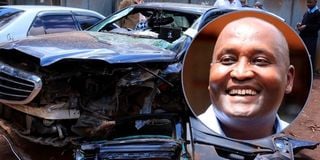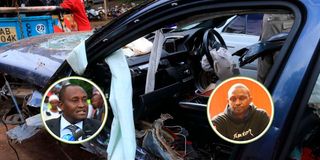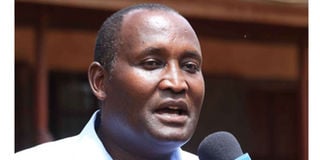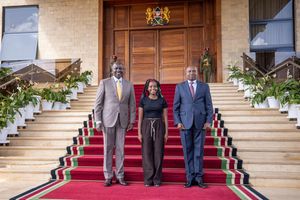
The vehicle of the late former Nyeri Governor Wahome Gakuru (inset), that crashed at Kabati on the Thika-Sagana highway in Murang'a County on November 7, 2017.
From the moment Mr Martin Nyuguto analysed the scene of a car crash at Kabati in Muranga County, in November 2017, he suggested Nyeri Governor Wahome Gakuru was assassinated, according to court testimony by witnesses who interacted with the detective.
Mr Nyuguto, the homicide boss at the Directorate of Criminal Investigations (DCI), intimated the same to the governor’s nephew Simon Waruru in 2017 and even disclosed that investigations were nearly complete.
Seven years later, Mr Nyuguto is adamant that the governor’s death was the result of an accident and that his employer, DCI, will soon arrest Mr Samuel Kinyanjui.
Mr Kinyanjui was the governor’s driver and was on November 7, 2017, tasked with ensuring Mr Gakuru arrived in Nairobi at 7am, one-and-a-half hours after leaving Nyeri.
Mr Nyuguto snubbed summons to appear before an inquest into the governor’s death. On Monday, he agreed to an interview with Nation, before postponing by a day.
On Tuesday, he cancelled the interview altogether.
“This was a road accident and the inquest has been concluded and directed to charge the driver. We are preparing to charge him and it’s always good practice and professional to report on the facts of the matter,” Mr Nyuguto told the Nation in a text message.
The homicide boss added that Mr Kinyanjui is out of the country, but that once back, he would be arrested and charged with causing death by reckless driving.

The vehicle of former Nyeri Governor the late Wahome Gakuru (inset, left). Inset (right): The former governor's driver Samson Kinyanyui Wanyaga.
The governor’s death triggered claims of foul play, which led to an inquest that concluded that the car crash was not planned.
On Monday, November 6, 2017, just a day before his death, Dr Gakuru, the third governor of Nyeri, spent much of the day juggling meetings and preparing for two television interviews set for the following day.
During lunch at a local hotel, he stepped in to mediate disputes within the county assembly leadership. Later, he visited his rural home in Kirichu to supervise the construction of his house.
As dusk fell, he retreated to his rented home in Nyeri’s Ring Road Estate.
That night, he hosted a casual hangout with his nephew, Simon Waruru, his personal assistant Albert Gakuru, and his close security aide Josephat Mwangi Maina, alias Baba Maina. They discussed the upcoming interviews, local politics and his safety.
The governor was set to leave for Nairobi that night. It was ‘only logic,’ witnesses testifying before an inquest into his death would later tell the court. His first interview was at 7 am, and most of his team had families in Nairobi. But at 9pm, he changed his mind and postponed the trip until morning.
“Dr Gakuru had told me that he was not comfortable staying the night in Nairobi because things were tense between him and his lover Wangui, who lived in Hurlingham. They had been having issues for about a month,” Baba Maina, who was also the governor’s longtime friend, told the inquest.
Dr Gakuru had separated from his first wife, Catherine Kirumba, who lived in Runda Estate.
They lived separately only appearing together at public events. The night stretched long. They made merry. But his nephew Waruru would later reveal to the inquest that the governor appeared uneasy that night.
“At one time, Baba Maina dozed off and dropped a glass. The governor was furious. He violently woke him up asking how he could entrust him with our security,” the governor’s nephew told the court.

The late Nyeri Governor Wahome Gakuru.
At around 2am, the meeting broke up, leaving the governor in the care of Baba Maina and a chef, with whom he lived. The plan was to leave at 4 am, but the governor woke an hour late.
By then, as heavy rains poured, his driver, Samuel Kinyanjui, and a security team were already waiting in a Toyota Corolla chase car outside.
The plan had been to drive a Pajero. Fuelled. Washed. Ready. But urgency trumped routine.
The governor hurried out, sliding into the front passenger seat of a Mercedes Benz, choosing it for its speed.
In his testimony before the inquest, Mr Kinyanjui stated that they left Nyeri at 5:30am, and needed to be in Nairobi at 7am.
The only stop they made was to pick up Albert, the personal assistant. During the stop, the seating arrangements were changed—Baba Maina moved to the chase car, and Albert took his seat.
The Mercedes was carrying the governor, his personal assistant, and Ahmed Khaib, his bodyguard. Throughout the journey, the governor barely spoke, spending most of the time on his phone.
When he did speak, it was only to his personal assistant. The inquest heard that the two discussed what was being broadcast on the car radio. The governor gave directions to the driver using only hand signals.
Heavy rain poured continuously, mist reduced visibility, and the wet roads were dangerously slippery. Despite the conditions, the Mercedes raced ahead.
Those in the chase car told the inquest that they occasionally lost sight of the governor’s vehicle, which was speeding at over 130 km/hour.
Just minutes after passing Makuyu town at Kabati near Makenji, tragedy struck. According to the driver’s testimony, the governor had instructed him to overtake a canter. In the attempt, he swerved into the right lane, but moments later, he lost control.
The speeding Mercedes hit a guardrail, dragging the car for 48.4 meters as the rail pierced through the front passenger seat where the governor sat.
The impact saw the rail penetrate the governor’s pelvic area, severed his personal assistant’s fingers, and injured his bodyguard’s right leg.
The backseat was torn from its position and flung onto the road. The driver walked away unscathed.
The chase car, which had fallen behind, was the first to arrive at the scene. Bystanders managed to rescue the injured personal assistant and bodyguard, but the governor remained trapped, bleeding heavily.
Witnesses recounted the governor’s agonising pain as they worked to free him. It took 45 minutes to remove him from the wreckage.
“The passenger’s door would not open, we tried to lift him but he was heavy. He was trapped in his seat- the space between him and the front was squeezed in. We had to pull the back seat with a crane so that we could remove him from the vehicle,” Police Constable Samuel Lekolol, one of the two bodyguards in the chase car, testified in court.
By this time, the governor’s personal assistant and bodyguard had already been rushed to the hospital in the governor’s chase car.
The court heard that, coincidentally, a private vehicle belonging to Keen Wachira—a political rival, happened to be passing by and took the governor to Thika Level Five Hospital.
Mr Wachira had contested the Nyeri gubernatorial seat in 2012 against Dr Gakuru. He said he was to attend a board meeting at the Athi Water Services Board.
At the Thika Level Five Hospital, the court heard that the governor was received by a team of interns.
Dr Loise Muthini, an intern on duty that day, testified during the inquest that the governor was brought in at the casualty ward at 7:25am in critical condition. She described him as pale, in shock, and bleeding heavily.
“His clothes were soaked in blood and his hands, eyes and tongue were very pale. He was speaking slowly, saying he was in pain and requested to be turned. We applied a pelvic binder to control the bleeding,” she recounted.
As his condition worsened, the medical team began resuscitation efforts, including administering adrenaline and preparing for a blood transfusion.
The inquest heard that the medical team at Thika Level Five Hospital included two interns, Margaret, an anaesthetist, the nursing team, and later, a consultant who joined the efforts.
They administered adrenaline to stimulate the governor’s heart, but he showed no signs of life.
By then, all the surgeons had arrived.
Cardiologist Dr Dan Gikonyo, who arrived during the resuscitation efforts, was the last to join the team.
He was the one who pronounced Dr Gakuru dead. Resuscitation had begun at 7:35am, ten minutes after the governor was brought in, and his death was confirmed at 8:25am.
A helicopter hired by the Council of Governors to airlift the governor to a more advanced facility arrived in Thika but did not land. It was too late—the governor had succumbed to his injuries.
Government pathologist Dr Johansen Oduor later concluded that the cause of death was exsanguination—severe blood loss—and lower back injuries.
“Forty minutes is enough for a person who is bleeding to die,” the pathologist told the inquest, noting that quicker intervention might have saved the governor’s life.
Witnesses testified that the emergency response teams arrived late at the scene of the accident and the governor’s life would have been saved had there been prompt services from emergency services.
During the inquest, Dr Gakuru’s family, through lawyer Martha Waweru, condemned the inadequate emergency response.
“The governor was left to the public to rescue him using crude tools. There were no county ambulances or emergency personnel at the scene, leading to significant delays in extricating the governor from the vehicle and transporting him to the hospital,” she said.
The accident left unanswered questions. Suspicions emerged during Dr Gakuru’s requiem mass on November 14, 2017, when his successor Governor Mutahi Kahiga, made a shocking revelation.
“Up to today, I keep asking everybody who cares to listen: how did Wahome Gakuru find himself in the Mercedes Benz outside Nyeri?” Mr Kahiga asked during the service.
“We had agreed not to use it because it was faulty. He had told me several times, ‘My brother, hii garindiyo itaniua. Wambugu, you remember?’ He had said that a thousand times. It was a faulty car.”
Court records indicate that Dr Gakuru’s driver, Mr Kinyanjui, had been instructed by Baba Maina to prepare for a trip to Nairobi early the following morning. The night before, the two fuelled a Pajero vehicle at 8:30pm and returned it to the residence.
However, the following morning, Baba Maina handed over the keys to the Mercedes Benz instead, the inquest was told.
When Kinyanjui questioned the change of plans, he was told the governor had ordered the use of the Mercedes Benz.
Mr Kinyanjui, an ambulance driver, had chauffeured Dr Gakuru for less than a week following frequent changes in the governor’s personal drivers.
This abrupt switch of vehicles stirred speculation, fuelling suspicions about the events leading to the tragic accident.
A day after the requiem mass, Mr Kinyanjui was arrested in Nyeri on accusations of dangerous driving.
A police officer, Corporal Francis Kisavi, later testified during cross-examination that the State counsel at Kigumo Court had received direct instructions from the Director of Public Prosecutions (DPP) not to register the matter. No reasons were provided for this decision.
Kinyanjui was subsequently released on a Sh20,000 cash bail.
Investigations into the accident began, with officers from Makuyu Police Station recommending that the governor’s driver be charged with causing death by dangerous driving.
“We took him to Kigumo Law Court to face the charges, but upon arrival, the State counsel informed us that he had received instructions from the Office of the Director of Public Prosecutions not to register the case,” Corporal Francis Kisavi, the investigating officer, wrote in his statement.
No reason was provided for the decision.
“They told us to wait for the file, so we returned to the police station, and the driver was released on a cash bail of Sh20,000,” Corporal Kisavi said.
This led to the initiation of a public inquest into the governor’s death, aimed at uncovering the cause of the tragic road crash and the circumstances surrounding the death of the former county boss.
When the inquest kicked off, county politics, the accident scene, Thika Level Five Hospital and the ill-fated Mercedes Benz became subjects of interest.
However, the investigations would later end in disarray after the family withdrew.
The inquest revealed the vehicle’s mechanical state, a delayed emergency response, Dr Gakuru’s troubled life, inner circle, and a marital dispute.
Corporal Kisavi was one of the first police officers at the scene of the accident. He described the vehicle’s damage, noting that it had hit 16 pillars of the guardrail leaving skid marks which indicated that the vehicle was at a very high speed and the driver could have tried applying emergency brakes.
The vehicle was initially towed to Makuyu Police Station and then transferred to the DCI offices in Nakuru.
During the inquest, Corporal Kisavi said that despite being the investigating officer in the case, he did not authorise its release and was unaware of the person who collected it.
During a further inquest hearing in August 2021, the court issued arrest warrants for Corporal Kisavi and three other officers for failing to appear at a site visit related to the inquest.
The court, however, later lifted the warrants of arrest after it was told that the officers did not receive the summons as they were on leave and others had been transferred.
But Dennis Ireri, an expert from the National Transport and Safety Authority (NTSA), testified that there were no skid marks at the scene, indicating that the driver did not attempt to apply the brakes before the vehicle collided with a guardrail.
He said that the vehicle had no pre-existing defects, noting that only the brake pipes were cut as a result of the accident.
Ireri also noted that the vehicle’s braking system was intact and operational, suggesting that the driver failed to brake despite the vehicle’s high speed.
He estimated the vehicle’s speed to be over 120 km/h, exceeding the recommended highway limit of 110 km/hr.
Additionally, Ireri noted that the vehicle continued to accelerate after hitting the first three concrete posts, bending them, and then flattening five more posts, indicating a high speed which contributed to the extent of the damage.

Senior Assistant Director of Public Prosecutions Peter Mailanyi cross-examines Samson Kinyanjui Wanyaga (right) on June 27, 2019 during an inquest into the death of former Governor Wahome Gakuru.
Mr Kinyanjui had told the inquest that after hitting the metallic barrier, his foot got stuck on the acceleration pedal. This caused the rail to pierce through the vehicle entering from the front and coming out at the rear for 66 metres.
Contrary to most of the witness accounts at the scene that the governor’s airbags failed to deploy, Ireri, who inspected the car at Makuyu Police Station on the same day, testified that all the airbags in the vehicle- both the driver’s side and co-driver's side deflated.
“The only reason why the airbag may not deflate is if anyone is not wearing a seatbelt,” he said.
It was this testimony that saw the court later find Kinyanjui culpable of dangerous driving.
In June this year, Nyeri Chief Magistrate Alfred Kibiru said that the governor’s driver was careless and reckless in his manner of driving.
As a result, the magistrate ruled that; “the issue of the maintenance of the late governor’s vehicle was raised, no evidence was tendered to indicate that the vehicle had any defects that could have led to the accident, the motor vehicle inspector testified that the car had no pre-accident defects.”
Dr Oduor had said that an autopsy showed that Dr Gakuru had a diagonal bruise which was linear on the left shoulder, 4cm long, and there was also a horizontal bruise on the lower abdomen that was 19cm long, located 17cm below the umbilicus and marks were well defined and were consistent with a safety belt.
There were also severe limb fractures, which could have been consistent with pressure from the safety belt.
Tomorrow: The troubled sunset days of Wahome Gakuru, and a bungled Benz probe.









